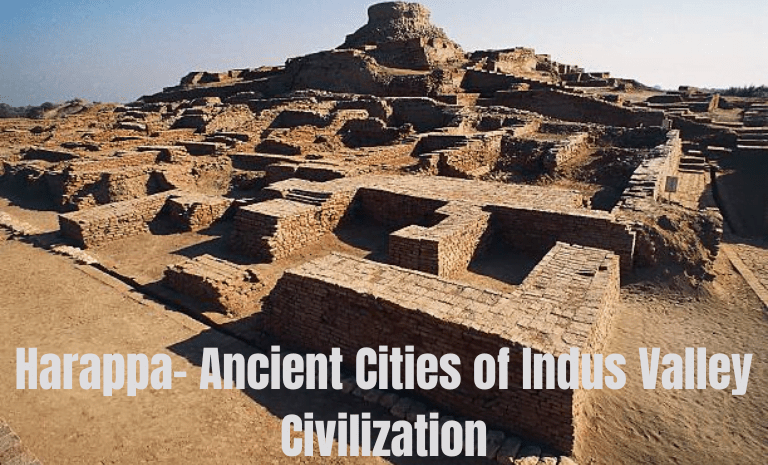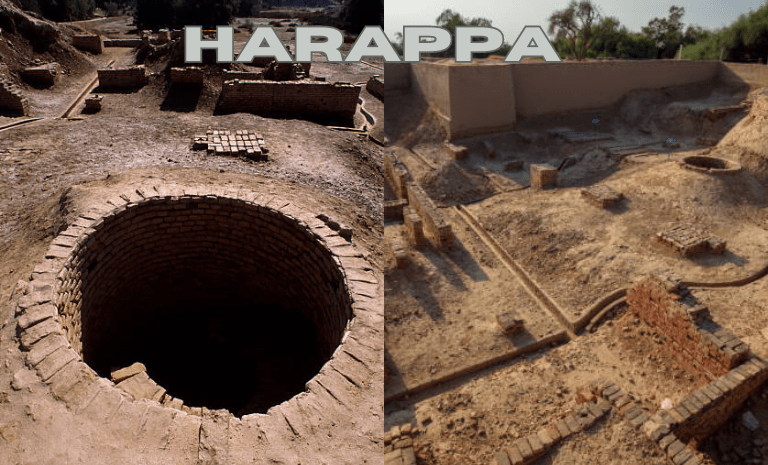Harappa- Ancient Cities of Indus Valley Civilization: The Indus Valley Civilization is one of the earliest civilizations that existed in the Indian subcontinent. The civilization was spread over a vast area, covering parts of present-day India, Pakistan, and Afghanistan. The cities of Harappa and Mohenjo-Daro are considered to be the most important sites of the Indus Valley Civilization. In this article, we will focus on the ancient city of Harappa.

Location
Harappa is located in present-day Punjab, Pakistan, near the Ravi River. The city was discovered in the 1920s by archaeologists, and it is believed to have existed between 2600 BCE to 1900 BCE.
Architecture and Urban Planning
The city of Harappa had a well-planned layout, with well-laid-out roads, drainage systems, and public buildings. The buildings were made of baked bricks and were multi-storied. The city was divided into two parts, the lower town, and the citadel. The citadel was a raised platform that was surrounded by walls and had public buildings like the Great Bath, a granary, and a Great Hall.
Art and Culture
The people of Harappa were skilled in various arts and crafts, including pottery, sculpture, and weaving. The city has provided many artifacts, including jewelry, pottery, and figurines, which give insight into the culture of the people who lived there. The people of Harappa had a writing system that has not yet been fully deciphered.
Read this
- The Indus Valley Civilization-10 Ancient Cities of Indus Valley Civilization
- Mohenjo Daro- Ancient Cities of Indus Valley Civilization
Trade and Economy
The Indus Valley Civilization had a well-developed economy and was involved in trade with other civilizations. Harappa was an important center for trade, and artifacts found in the city suggest that it had trading links with Mesopotamia, Iran, and Central Asia.

Religion
The religion of the people of Harappa is not yet fully understood, but it is believed that they worshipped a mother goddess. Many figurines found in the city depict a female figure, which is believed to be a representation of the mother goddess.
Decline and Disappearance
The reasons for the decline of the Indus Valley Civilization are not yet fully understood. It is believed that a combination of factors like climate change, natural disasters, and invasions by outsiders led to the decline of the civilization. The city of Harappa was abandoned around 1900 BCE, and the civilization gradually disappeared.
Rediscovery and Preservation
The city of Harappa was rediscovered in the 1920s by archaeologists, and since then, many excavations have been carried out in the city. The city has been declared a UNESCO World Heritage Site, and efforts are being made to preserve the site and its artifacts.
Conclusion
The city of Harappa is an important site of the Indus Valley Civilization and provides valuable insight into the life and culture of the people who lived there. The well-planned layout, the artifacts, and the architecture of the city are a testament to the advanced civilization that existed in the Indian subcontinent thousands of years ago.
Additional Resources
If you want to learn more about the Indus Valley Civilization, Harappa, and other ancient civilizations, here are some additional resources that you may find useful:
- “The Ancient Indus Valley: New Perspectives” edited by Jane R. McIntosh
- “Indus Valley Civilization: A History from Beginning to End” by Hourly History
- “The Indus Civilization: A Contemporary Perspective” edited by Gregory L. Possehl
Conclusion
The city of Harappa is an important site of the Indus Valley Civilization and provides valuable insight into the life and culture of the people who lived there. The city’s well-planned layout, artifacts, and architecture are a testament to the advanced civilization that existed in the Indian subcontinent thousands of years ago. Despite the decline of the Indus Valley Civilization, its legacy lives on, and we continue to learn more about this fascinating ancient civilization through ongoing research and archaeological discoveries.